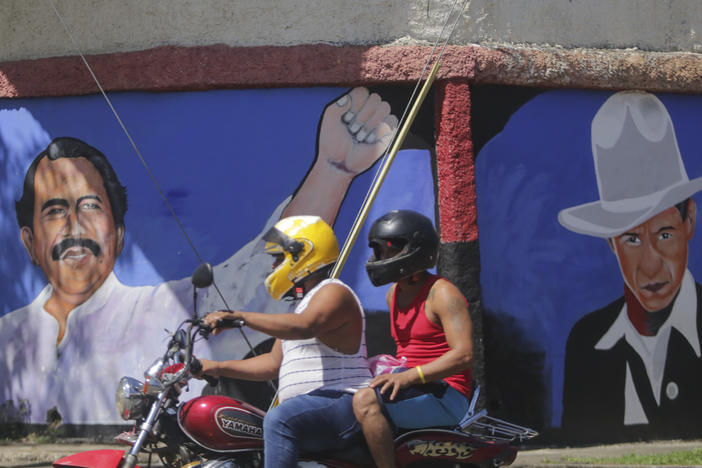Section Branding
Header Content
Reporting on your colleagues' murders changes how you work
Primary Content
"I fear for my life."
That's what reporter Lourdes Maldonado told Mexico's President Andrés Manuel López Obrador during a press conference nearly three years ago.
Last Sunday night, Maldonado was shot dead outside of her home in Tijuana.
She is the second journalist to be murdered in the city in less than a week — the third killed in Mexico already this year — which has cast a pall on reporters there, as they take photos of their colleagues' dead bodies and write about and investigate their deaths.
While the motives for the killings are not clear, it's prompting other journalists in Tijuana to take stock.
Numb to violence
"This has been a very difficult week, and we have been doing a lot of soul searching here in our newsroom, just because we are so used to violence," Vicente Calderon, an independent reporter in Tijuana who directs Tijuanapress.com, told NPR's All Things Considered.
"We know these guys. We shared time and we talked during press conferences, at crime scenes and at other stories. Honestly, I'm not sure if I'm really processing my feelings right now because I'm just not that shocked yet. You kind of learn to deal with violence because you are covering it on a daily basis."
More than 1,900 people were killed in Tijuana just last year. That's one of the highest annual body counts for any city in the country.
On Tuesday evening, thousands of journalists took to the streets in cities across Mexico to express their outrage and grief over the journalists' killings.
Calderon says in the wake of the murders of his colleagues, reporters in Tijuana are trying to be more conscious of their surroundings, and just more alert. "Unfortunately, this is not the first time that we are facing this," he lamented. "In 1988, [I was] doing the same, demanding justice for another colleague gunned down. And here we are again in 2022."
In 1988, Hector "Gato" Felix Miranda, an editor for the crusading weekly publication Zeta was ambushed on his way to work. Felix was often critical of Tijuana authorities and prominent businessmen.
Even in a city with a high number of murders in recent years, the killing of two journalists in less than a week is unprecedented. More broadly, Mexico is one of the most dangerous places in the world for reporters, according to the Committee to Protect Journalists. The group counts nine reporters killed there last year, though it's not clear if all were targeted for their work.
Calderon said he feels afraid in the face of the violence, but he cannot let fear derail his work. "I'm afraid there's no guarantees for a regular level of journalism. But, still, we find ways to produce our stories. Sometimes we have to hold it for some time. Sometimes we have to look for other avenues to publish it without being linked to that particular story."
"Luby" and "4-4"
Maldonado, the reporter who was killed last Sunday night and was affectionately known as "Luby", had worked for various media outlets in Tijuana for decades. She had recently won a protracted labor dispute with a previous employer, PSN, a media company owned by the former governor of Baja California, Jaime Bonilla. Maldonado sued Bonilla's company for $20,000 in back wages after she was improperly fired.
Two days before her death, she was happy and looked forward to gaining access to some of PSN's accounting records, as granted by a recent court ruling in her favor, according to El Sol newspaper. However, she told the Tijuana-based outlet that she was also concerned about what she would find in the papers. Possessing proof of malfeasance by the ex-governor could put her in danger.
Bonilla has denied any involvement in Maldonado's murder.
Photographer Margarito Martinez was killed six days earlier as he got into his car outside his home in Tijuana to head to a crime scene. He'd made a career, over two decades, of photographing grisly murders in the city at all hours. He also worked as a "fixer" for many international media outlets.
Martinez's nickname was "4-4", like the shorthand police use over their radios, for his signature way of letting his colleagues know when it was safe to come to a crime scene. He was often the first to arrive. Martinez had recently had a public spat with a man who posts about local crime on social media. The crime blogger had accused Martinez of running social media sites on behalf of a criminal group.
Reporters want answers
Authorities have said they're investigating both murders. They have not said whether Martinez and Maldonado were targeted because they were journalists.
Reporter Calderon said journalists in Tijuana want answers. "We need to keep the pressure on the authorities to investigate that possibility. ... We need to be very cautious and mindful that there are many other reasons. ... We need to be responsible and ethical in that sense," cautioned Calderon.
Both Martinez and Maldonado had reportedly asked for state police protection. Calderon said that can come in many forms. "A panic button in your home, that she [Maldonado] apparently did have, a police escort, they can even pull you out of the city to a safer place. But, there's a wide perception that the mechanism is not good enough. I mean, several of our colleagues in Mexico have been killed while being part of the mechanism of protection for journalists."
Calderon said part of the problem was the violence was not just against journalists. "The problem is that violence is against everybody and it's very easy to kill somebody and not face consequences in this country."
Only about 2% of murders in Mexico are ever solved.
Copyright 2022 NPR. To see more, visit https://www.npr.org.
Bottom Content








